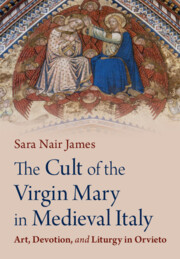Refine search
Actions for selected content:
354 results
4 - The Inaugurators of Scholasticism: Language and Theology in the Twelfth Century
- from Part I - Historical Context
-
-
- Book:
- The Origins of Scholasticism
- Published online:
- 18 November 2025
- Print publication:
- 08 January 2026, pp 116-154
-
- Chapter
- Export citation
Chapter 2 - The Renaissance and the Ancient
-
- Book:
- The Italian Renaissance
- Print publication:
- 31 December 2025, pp 23-64
-
- Chapter
- Export citation
Chapter 5 - Tragedy and the Best Life in the Gorgias
-
- Book:
- Plato on Comedy and Tragedy
- Published online:
- 24 October 2025
- Print publication:
- 13 November 2025, pp 164-187
-
- Chapter
- Export citation
4 - Communicating the Message
- from Part II - The World of the Text
-
- Book:
- The Gospel of Truth
- Published online:
- 23 October 2025
- Print publication:
- 06 November 2025, pp 76-105
-
- Chapter
- Export citation
8 - Voluntary Compliance and the COVID-19 Pandemic
-
- Book:
- Can the Public be Trusted?
- Published online:
- 11 October 2025
- Print publication:
- 30 October 2025, pp 186-204
-
- Chapter
-
- You have access
- Open access
- HTML
- Export citation
Chapter 13 - Kant and the Moral Challenges of Rhetoric
- from Part II - Historical and Philosophical Implications
-
-
- Book:
- Kant on Language
- Published online:
- 19 September 2025
- Print publication:
- 09 October 2025, pp 234-253
-
- Chapter
- Export citation
Chapter 4 - Cicero’s De morte
-
-
- Book:
- Cicero's <i>Tusculan Disputations</i>
- Published online:
- 11 September 2025
- Print publication:
- 18 September 2025, pp 56-78
-
- Chapter
- Export citation
The Rhetoric of Emulation: Debating Emigrant Enfranchisement in Canada
-
- Journal:
- Canadian Journal of Political Science/Revue canadienne de science politique , First View
- Published online by Cambridge University Press:
- 05 September 2025, pp. 1-25
-
- Article
-
- You have access
- Open access
- HTML
- Export citation
Chapter 10 - Stand-Up Comedy and Offence
- from Part II - Interpretation and Meaning
-
-
- Book:
- The Cambridge Companion to Stand-Up Comedy
- Published online:
- 21 August 2025
- Print publication:
- 04 September 2025, pp 189-205
-
- Chapter
- Export citation
Chapter 1 - Into the Backcountry
-
- Book:
- Healing and the Invention of Metaphor
- Published online:
- 17 July 2025
- Print publication:
- 31 July 2025, pp 1-32
-
- Chapter
-
- You have access
- HTML
- Export citation

The Cult of the Virgin Mary in Medieval Italy
- Art, Devotion, and Liturgy in Orvieto
-
- Published online:
- 24 July 2025
- Print publication:
- 24 July 2025
9 - Press Benefits and the Public Imagination
- from Part III - Evolving Threats to the Press Function
-
-
- Book:
- The Future of Press Freedom
- Published online:
- 25 July 2025
- Print publication:
- 24 July 2025, pp 116-127
-
- Chapter
-
- You have access
- Open access
- HTML
- Export citation

The Theology of the Book of Leviticus
-
- Published online:
- 18 July 2025
- Print publication:
- 07 August 2025
The Ethics and Epistemology of Persuasion
-
- Journal:
- Canadian Journal of Philosophy / Volume 54 / Issue 4 / May 2024
- Published online by Cambridge University Press:
- 18 June 2025, pp. 314-328
-
- Article
-
- You have access
- Open access
- HTML
- Export citation
2 - A Land of Many Tongues
-
- Book:
- Neil MacCormick
- Published online:
- 22 May 2025
- Print publication:
- 12 June 2025, pp 77-115
-
- Chapter
- Export citation
Chapter 2 - Orator 2.0 (79–71)
-
- Book:
- Cicero
- Published online:
- 10 June 2025
- Print publication:
- 29 May 2025, pp 66-88
-
- Chapter
- Export citation
Chapter 1 - An Orator’s Education (106–80)
-
- Book:
- Cicero
- Published online:
- 10 June 2025
- Print publication:
- 29 May 2025, pp 23-65
-
- Chapter
- Export citation
Homer in Irenaeus
-
- Journal:
- Harvard Theological Review / Volume 118 / Issue 2 / April 2025
- Published online by Cambridge University Press:
- 30 July 2025, pp. 264-284
- Print publication:
- April 2025
-
- Article
-
- You have access
- Open access
- HTML
- Export citation
Stigma and the pejorative use of disabling conditions
-
- Journal:
- The British Journal of Psychiatry / Volume 226 / Issue 4 / April 2025
- Published online by Cambridge University Press:
- 29 April 2025, pp. 197-199
- Print publication:
- April 2025
-
- Article
-
- You have access
- HTML
- Export citation
21 - Papal Patronage and the Reception of Classicism in Medieval Rome
- from Part IV - Education, Culture, Arts
-
-
- Book:
- The Cambridge History of the Papacy
- Published online:
- 28 February 2025
- Print publication:
- 20 March 2025, pp 601-627
-
- Chapter
- Export citation
